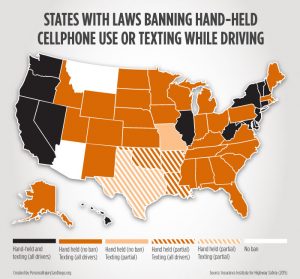What is distracted driving?
We teach in defensive driving class that distracted driving is any activity that could divert a person’s attention away from the primary task of driving. All distractions endanger driver, passenger, and bystander safety. These types of distractions include:
- Texting
- Using a cell phone or smartphone
- Eating and drinking
- Talking to passengers
- Grooming
- Reading, including maps
- Using a navigation system
- Watching a video
- Adjusting a radio, CD player, or Podcasts

The Next thing we teach in defensive driving class is because text messaging requires visual, manual, and cognitive attention from the driver, it is by far the most alarming distraction.
Another thing we teach in defensive driving class is that the best way to end distracted driving is to educate all Americans about the danger it poses. On this page, you’ll find facts and statistics that are powerfully persuasive. If you don’t already think distracted driving is a safety problem, please take a moment to learn more. And, as with everything on Distraction.gov, please share these facts with others. Together, we can help save lives.
Key Facts and Statistics
The number of people killed in distraction-affected crashes decreased slightly from 3,360 in 2011 to 3,328 in 2012. An estimated 421,000 people were injured in motor vehicle crashes involving a distracted driver, this was a nine percent increase from the estimated 387,000 people injured in 2011.
As of December 2013, 153.3 billion text messages were sent in the US (includes PR, the Territories, and Guam) every month.(CTIA)
10% of drivers of all ages under the age of 20 involved in fatal crashes were reported as distracted at the time of the crash. This age group has the largest proportion of drivers who were distracted.
Drivers in their 20s make up 27 percent of the distracted drivers in fatal crashes. (NHTSA)
At any given daylight moment across America, approximately 660,000 drivers are using cell phones or manipulating electronic devices while driving, a number that has held steady since 2010. (NOPUS)
Engaging in visual-manual subtasks (such as reaching for a phone, dialing and texting) associated with the use of hand-held phones and other portable devices increased the risk of getting into a crash by three times. (VTTI)
Five seconds is the average time your eyes are off the road while texting. When traveling at 55mph, that’s enough time to cover the length of a football field blindfolded. (2009, VTTI)
Headset cell phone use is not substantially safer than hand-held use. (VTTI)
A quarter of teens respond to a text message once or more every time they drive. 20 percent of teens and 10 percent of parents admit that they have extended, multi-message text conversations while driving. (UMTRI)
If you do get an Arizona traffic ticket take our defensive driving class. 2passdd.com